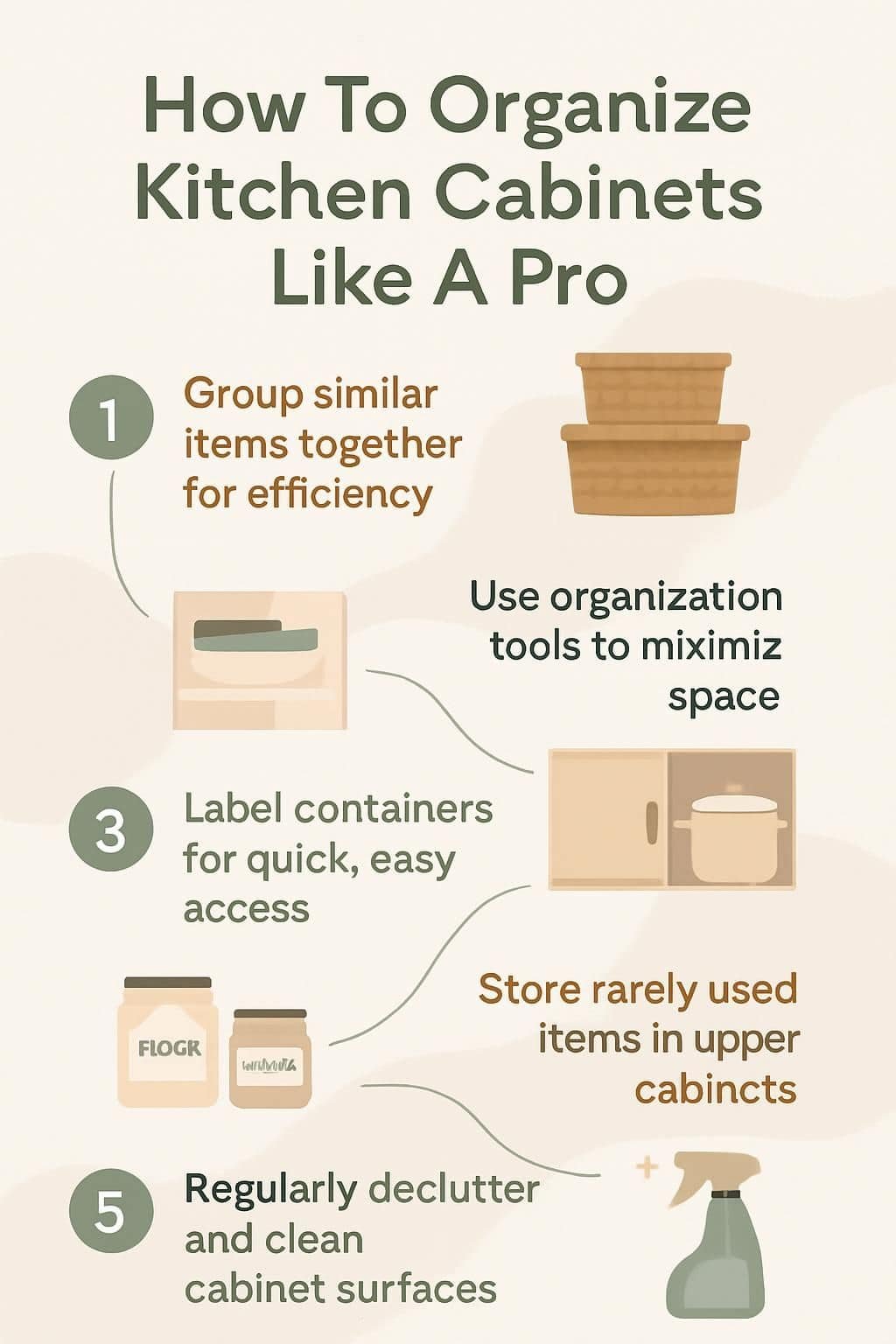Kitchen cabinets often end up messy and packed with cookware, food storage containers, and forgotten kitchen appliances. Many families struggle to find the item they need because everything from cookie sheets to silverware gets mixed together in cluttered spaces.
This can make cooking stressful for busy parents who want a smooth routine.
Studies show that organized kitchen cabinet space makes daily tasks faster and less frustrating. Setting up clear kitchen zones helps everyone know where things belong. This blog post will show step-by-step home organization tips on how to organize kitchen cabinets like a pro using simple tools like shelf risers, drawer dividers, and airtight containers.
Get ready for a smart guide on making your kitchen storage work better for you. You don’t want to miss these easy solutions!
Key Takeaways
- Group similar items together in kitchen cabinets. Place daily-use dishes near the dishwasher, and store spices close to the stove for easy access.
- Use organization tools like shelf risers, drawer dividers, pull-out racks, hooks, and tension rods. These tools help maximize cabinet space and keep things neat.
- Label clear containers or bins for pantry goods. This makes it easy to find what you need fast and keeps food fresh longer.
- Store rarely used items in upper cabinets or harder-to-reach spots. Keep often-used pots, pans, and utensils within arm’s reach to save time during meal prep.
- Regularly review your setup by decluttering unneeded gadgets and reorganizing as cooking needs change. Clean all cabinet surfaces each time you rearrange for better results.

Start with a Plan

Creating a strong plan sets the foundation for effective kitchen cabinet organization. Homeowners should assess their cooking needs and available space to develop clear zones, ensuring every item has a designated spot.
Assess your space and needs
Empty all items from the kitchen cabinets to get a clear view of every shelf, drawer, and section. Examining empty cabinetry helps spot wasted space and awkward corners often missed during daily use.
Clean each surface with warm soapy water after removing everything. Use this chance to measure cabinet dimensions for future storage bins or organizers.
Group similar items together as you go through them, such as grouping cookware and bakeware separately from food storage containers and tableware. Discard unnecessary or duplicate kitchen gadgets that crowd shelves but never get used.
Consider family cooking habits—households who cook pasta weekly need their pots and pans handy, while rarely-used iron skillets can move higher up in the pantry cabinet. This approach ensures the new kitchen organization meets real needs rather than cluttering valuable zones within your home’s busiest room.
Create designated zones for items
Group similar items together in dedicated kitchen zones to boost efficiency. Place daily-use dishes, bowls, and cups near the dishwasher for quick unloading. Store spices and cooking oils close to the stove so meal prep stays simple.
Use drawer dividers for organizing utensils such as spatulas and tongs near food prep areas. Set aside a section of cabinets or shelves just for pantry staples in airtight containers or storage bins.
Reserve lower shelves for heavy cookware like cast iron skillets or large pots that families grab often. Stash rarely used bakeware on higher shelves out of reach from children but still accessible when needed.
Separate table settings from food storage containers to prevent clutter and confusion during busy mornings or dinners with kids at home. Smart zoning uses cabinet real estate well while keeping every part of kitchen organization practical for parents managing family life.
Declutter and Clean
To declutter, start by removing items you no longer use. Clean all surfaces with a damp cloth to create a fresh space for kitchen storage solutions.
Remove unnecessary items
Clear out kitchen cabinets by sorting and removing unnecessary items. Take everything out for a better view of what you have. Check each item for duplicates, expired pantry goods, broken utensils, or unused cookware.
Many kitchens collect extra mugs, food storage containers without lids, and old cooking utensils that take up needed space.
Group similar things together as you go to make organizing easier later. Place unwanted or unused items in a donate box right away instead of letting them pile up on counters. This step makes it simple to see how much room remains before cleaning surfaces during the next stage of kitchen cabinet organization.
Clean and wipe down all surfaces
After removing unnecessary items, focus on cleaning. Empty all items from the kitchen cabinets. This step clears the way for a thorough clean.
Grab your favorite cleaning supplies and get to work. Wipe down all surfaces inside the cabinets. Don’t forget about countertops and other nearby areas as well; these spaces collect dust and grime over time.
A clean kitchen creates a fresh environment for organizing your kitchen storage solutions, making it easier to arrange everything neatly afterward.
Maximize Cabinet Space
To maximize cabinet space, use shelf risers and inserts to create extra layers for your items. Install pull-out racks or organizers for easy access, and consider adding hooks or tension rods to hold utensils or towels in place.
Use shelf risers and inserts
Shelf risers maximize vertical space in kitchen cabinets. They create extra layers for better organization of smaller items. This method helps house owners store more without crowding the cabinet.
Inserts also complement drawer dividers and turntables, making every inch count.
Choosing shelf risers allows parents to keep frequently used items within easy reach. Grouping similar items together promotes a neat appearance while simplifying access. Designating specific zones for related utensils further enhances functionality and ensures a clean, organized kitchen space.
Install pull-out racks and organizers
Install pull-out racks and organizers to maximize cabinet space effectively. These systems enhance functionality by providing easy access to kitchen items. House owners can reduce clutter and improve organization with these solutions.
Customizable options fit various cabinet sizes, helping create designated zones for pots, pans, or spices. Better visibility of items allows users to find what they need quickly.
Using pull-out racks simplifies cooking and meal prep. Parents will appreciate how easily children can reach their favorite snacks or utensils. With the right setup, kitchen organization becomes straightforward and efficient.
Integrating these organizers transforms cabinets into practical storage areas that meet everyone’s needs in the family kitchen.
Add hooks or tension rods for extra storage
Hooks and tension rods greatly increase storage in kitchen cabinets. Use hooks on cabinet doors to hang utensils, measuring cups, or small tools. Tension rods can create additional shelving for items like cutting boards or pans.
This vertical storage solution maximizes space while keeping frequently used tools within easy reach.
Organizing with these additions sustains a clutter-free environment. Hooks keep essential items visible and accessible, preventing them from getting lost in deep cabinets. Incorporating hooks and tension rods improves kitchen organization and elevates functionality for busy households.
Organize by Accessibility
Keep often-used items within easy reach. Place seldom-used utensils and appliances in upper cabinets. This setup saves time and makes cooking more enjoyable. Use drawer dividers to separate tools like spatulas from measuring cups.
Store pots and pans in lower drawers for quick access while cooking. Adjust your storage habits based on how frequently you use each item, making life simpler in the kitchen.
Keep frequently used items within reach
Position frequently used items in easily accessible spots. This enhances functionality and saves time while cooking. Spices should be placed near the stove for easy access during meal prep.
Store pots, pans, and utensils within arm’s reach to allow for smooth transitions while preparing dishes. Parents will appreciate having kid-friendly snacks at a lower level, making it simple for children to grab their favorites independently.
Consider dedicating specific zones in cabinets for these essential items. Group similar tools or ingredients together to make locating them quicker and more efficient. Keeping often-used products within reach will streamline kitchen tasks and create a more organized space.
Store rarely used items in upper cabinets
Store rarely used items in upper cabinets to enhance kitchen organization. This strategy keeps frequently used items easily accessible and organized effectively. Utilize this upper space for things not needed daily.
Clear labeling helps identify these items when necessary. Consider using bins or containers to group similar seldom-used objects together for better organization. Regularly reassess the contents of your upper cabinets; decide if they still belong there or can be decluttered.
This approach maximizes kitchen storage and creates a more functional cooking area.
Utilizing awkward spaces can add even more efficiency to your kitchen organization.
Utilize Awkward Spaces
To maximize every inch of your kitchen, use turntables in those tricky corner cabinets. Store vertical items like cutting boards and baking sheets upright to save space and keep them easily accessible.
Use turntables for corner cabinets
Turntables fit perfectly in corner cabinets, making hard-to-reach spaces easy to use. They help organize awkward kitchen areas by rotating items into view. This design keeps frequently used kitchen tools accessible while preventing clutter.
Items stay neatly arranged and easy to find, improving kitchen functionality.
Combining turntables with other storage solutions like shelf risers or pull-out racks maximizes the space even more. Homeowners appreciate how these devices work well together within designated zones for greater efficiency.
Shifting focus now turns to grouping and arranging items strategically for the best organization in every cabinet.
Store vertical items like cutting boards and baking sheets
Utilize vertical storage for cutting boards and baking sheets. This method maximizes space in kitchen cabinets. Store these items upright, allowing easy access when needed. Vertical organization also helps in reducing clutter on countertops, making the kitchen feel more open.
Consider adding drawer dividers to keep everything organized. These tools enhance the structure of vertical items, preventing them from toppling over. By sorting and categorizing these essentials clearly, homeowners can improve their kitchen cabinet organization significantly.
Group and Arrange Items Strategically
Grouping similar items makes kitchen storage more efficient. Place plates with plates and glasses with glasses. Arrange pots and pans together to save time during cooking. Use bins or baskets for easy access to frequently used utensils.
Stacking dishes or nesting smaller bowls inside larger ones saves space too. This method keeps everything tidy and easily reachable, making meal prep a breeze.
Group similar items together
Grouping similar items together simplifies kitchen cabinet organization. Keep dishes near the dishwasher for quick unloading and easier access. Store cooking utensils close to pots and pans, making meal prep smoother.
Place spices near the stove so they are readily available while cooking.
Use stackable containers for snacks, or group food storage containers in one area. Cluster bakeware with mixing bowls to create a baking zone. Organizing this way saves time and effort during busy cooking sessions.
It also ensures that everything has its place, improving kitchen efficiency without cluttering cabinets.
Stack dishes and nest smaller items inside larger ones
Stacking dishes saves space and creates a tidy look in kitchen cabinets. Place larger plates on the bottom and stack smaller ones on top. This method keeps everything organized and easy to access.
Nesting smaller items inside larger ones maximizes cabinet space effectively. For example, store measuring cups within mixing bowls or place small containers inside bigger food storage bins.
These simple strategies enhance kitchen organization and help parents find what they need quickly. Moving forward, explore ways to label and maintain your organization system efficiently.
Label and Maintain Organization
Labels help keep kitchen cabinets tidy. Use labels on containers, bins, and shelves to identify contents quickly. Clear storage bins can also streamline pantry organization. Regularly check your setup to ensure it meets your needs and stays clutter-free.
Use labels or clear containers for pantry items
Organizing pantry items becomes simple with labels or clear containers. These tools help house owners and parents quickly identify everything they store. Use airtight containers for food storage to keep items fresh longer.
Label each container for easy access and clarity.
Group similar items together to improve organization. Clear bins allow visibility, so anyone can find what they need at a glance. This method also minimizes clutter on shelves, making kitchen cabinet organization more efficient.
Regularly check the contents of these containers to maintain order in your pantry space.
Regularly review and reorganize as needed
House owners should regularly review and reorganize their kitchen cabinets. This practice helps maintain a tidy space and ensures that items remain easy to find. By emptying and cleaning the cabinets thoroughly, they can effectively assess what is truly necessary.
During this process, sorting through clutter allows for removing unnecessary items.
Grouping similar items into categories enhances organization further. Place frequently used tools like food storage containers or cooking utensils within reach. Store rarely used gadgets in upper cabinets to optimize accessibility.
With these steps, kitchen cabinet organization becomes straightforward and efficient, making daily tasks much easier for parents managing busy households.
Conclusion
Organizing kitchen cabinets transforms any space into a functional area. House owners can create designated zones, making it easy to find items. Utilizing drawer dividers and shelf risers maximizes every inch of storage.
Keeping frequently used tools close provides convenience during meal prep. Regularly review the setup to maintain an efficient kitchen environment.
FAQs
1. How do I start kitchen cabinet organization for better storage?
Begin with kitchen decluttering. Remove unused items from your cabinets and pantry cabinet. Use storage bins to group similar items together, making it easier to find what you need.
2. What are the best kitchen storage solutions for small spaces?
Use vertical storage like shelf risers and tension rods to maximize space in tight cabinets or above-cabinet storage areas. Lazy Susans help reach items in hard-to-access corners.
3. Which tools help organize food containers in my pantry cabinet?
Airtight containers keep dry goods fresh and visible while drawer dividers sort utensils or lids efficiently within drawers or on shelves.
4. How can I set up effective zones for kitchen organization?
Create specific kitchen zones based on tasks such as cooking, baking, or prepping meals; store related items near each zone using appropriate kitchen storage options like bins and baskets.
5. Are there expert home organization tips that make a difference long-term?
Store everyday essentials at eye level inside your cabinets; reserve less-used cookware for higher shelves or above-cabinet spots. Regularly review contents of your kitchn area to maintain order and adapt your pantry organization as needs change over time.


